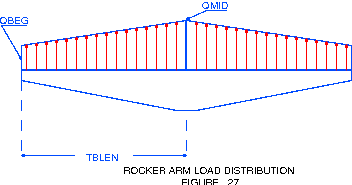Q:
How can I determine if 2nd tip has occured?
REV 7.05
A: Look at the results in the Skidway Reaction report. This is the table created by the "LWFORCE" comannd. The column labeled distance will have a "jump". The values in this column decrease as the jacket slides off the barge. When the 2nd rocker arm is active the distance increases to show the new distance to the 2nd pin.
Q:
What is the basis for the suggested added mass
and damping for launch barges?
REV 7.04
A: Originally these numbers were based on the high frequency results in a frequency domain analysis for nominal launch barge in a nominal launch position. These values have been used used for the launch analyses since 1980s. and some slight changes have been made based on feedback from the actual launches.
Q:
How can I find out when free sliding occurs?
REV 7.04
A: There is no unique answer to the question. MOSES reports the first time that no winch force is required to move the jacket at the specified speed. At times later, the winch may have to be applied again to keep the jacket moving at the specified speed.
Q:
What do you mean by "length of leg on deck" in the jacket launch
analysis output?
REV 5.08
A: Length of leg on deck is the distance from the rocker pin to the trailing edge of the jacket. This is always measured along the jacket leg, regardless of jacket orientation. To determine when a jacket support point passes the rocker pin, you need to equate the length of leg on deck to the distance from the trailing edge to the support point. The string function &POINT(D_NODE *N1 *N2) is useful for this. If you were to use the automated launch macros, the load cases would be generated automatically for you, as each support point passes the pin, and as each midspan point passes the pin. If you allow the simulation to go beyond separation, the macro also creates load cases at maximum post separation velocity, to capture drag dominated members.
Q:
How can I position a jacket so that the center
of gravity (which is off center) is at the
center line of the barge?
REV 5.08
A: You need to specify the proper Y coordinates on the LLEG command for the beginning of the skidway, and the rocker pin using the -TPIN option. For example:
ASSEMBLY LLEG *j1 *j2 barge 0 25+1 25 *B@ -tpin 5 300 25+1 20
ASSEMBLY LLEG *j3 *j4 barge 0 -25+1 25 *B@ -tpin 5 300 -25+1 20
will shift the skidways one unit to starboard.
Q:
Why does the results I get from my launch using
&INSTATE -EVENT T followed by &STATUS XXX
differ from what is reported in PRCPOST?
REV 5.08
A: What is reported with &STATUS is for a static situation, so it is not really surprising that these results differ from those during the dynamics! This statement is valid regardless of the type of time domain simulation, but particularly for a launch. During a launch, various connectors interact and for MOSES to know the complete story, one must look at the history. For example, suppose that you selected an event after tipping. Here the pitch of the barge is different from that of the jacket. The launch way connectors will try to make the two pitches equal and what you get may have no relation to what is actually going on during the simulation.
In conclusion, &INSTATE -EVENT gets the state information at a particular event and set it as the current condition. If there is no dynamics going on, then this is a reasonable approximation to the dynamic state. If not, however, anything you get with &STATUS will be rubbish.
Q:
The barge I'm considering for my jacket launch analysis has only
the primary rocker beam. The total length of this beam is
15.25 m (ie 6.1m from from pin aft and 9.15m from pin forward). If
I want to use a conservative load distribution of 10% 80% 10%
for my launch stress analysis, what value of my "tblen" in the
"-LLFOR" option should be. Is it 6.1m or 15.25/2 ?
REV 5.08
A: To be conservative, you should use the shorter length of 6.1 meters.
Q:
If I take your advice in the question above and I use 6.1m
and my QMID and QBEG are 88.9 and 11.1, and the
TBLEN is not 1/2 of my rocker beam (15.25/2), how will MOSES
distribute the loads at the beginning of the rocker beam?
REV 5.08
A: The loads will be distributed according to the documentation in the User's Reference Manual. Specifically, the load is distributed according

using a trapezoidal distribution. 88.9% of the load will be at the pin, with 11.1/2 at the forward end of the rocker arm, and 11.1/2 at the aft end of the rocker arm. The total length of the rocker arm will be assumed to be 6.1*2 meters, or 12.2 meters. You can view the manaul page on -LAUNCH by clicking here.
Q:
Is it possible to obtain the minimum GM of the jacket
during a launch simulation?
REV 5.06
A: GM is a measure of stability and stability only makes sense with respect to a "singular point" of the equations of motion (an equilibrium position or a constant velocity state). During launch, there is acceleration and hence, GM would not be useful here.
I think that the reason you are interested in GM is to see what happens if the jacket stops during the launch. If this is the case, you can: move the jacket to a position, find equilibrium, and then see how stable it is.
